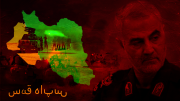
Robert Clark
The contrast couldn’t be starker. Across the streets of Baghdad and Syria, jubilant crowds of civilians who have lived for too longer under the fear of Qassem Soleimani and his proxy regional Shi’ite brigades rejoice to the news of his death. Over the border in Iran, a period of mourning for a man who whilst still widely feared, was also respected for both his military planning and astute diplomacy in regional affairs concerning the Iranian regime.
As thousands of mourners gathered over the weekend in the south western Iranian city of Ahvaz to greet the body of Qassem Soleimani, the ramifications of his death have barely begun. Whilst Tehran promise revenge, sure enough in coming, Europe urges restraint and ‘de-escalation’ on both sides, even as Iranian missiles crash into Baghdad’s Green Zone, only meters away from the US embassy.
Be under no illusion, the geopolitical landscape of the Middle East has now changed, and in seismic dimensions. Not only will these actions lead to a total redrafting of both US and Iranian strategy and the rules of engagement for pursuing desired ends, but significantly after a year of passive tolerance toward repeated Iranian aggression it has firmly placed US deterrence front and centre in Middle East security affairs.
The targeted killing of Major General Qassem Soleimani, the head of the elite Iranian Quds Force, by a US MQ-9 Reaper drone last Friday morning outside Baghdad airport along with Abu Mahdi al-Muhandis, his Iraqi militia leader ally, has raised many issues concerning Iranian and US strategy in the Middle East. As Tehran has sought to increase its leverage in regional affairs, best demonstrated through its proxies across ongoing conflicts, the US under President Trump has found itself lacking a clear and coherent Middle East strategy.
Whilst the Iranian regime has weathered crippling sanctions it has continued large-scale proxy warfare across the Middle East to further its own agenda whilst countering Saudi and US influence. It continues to repeatedly breech the terms of the failing Joint Comprehensive Plan of Action (JCPOA) in pursuit of a nuclear weapon, and adds to the increasingly unstable situations in Syria, Yemen and Iraq.
Since the US left the JCPOA, commonly referred to as the Iran deal, last year, and the re-imposition of crippling sanctions, Tehran has struggled economically at home, whilst still spending billions of dollars in its regional foreign policy agenda; namely, arming and supporting Shi’ite militias across the Shi’ite crescent. Stretching from Lebanon, Syria, Iraq, Yemen and into Afghanistan and Pakistan, under the Quds Force and Soleimani in particular Iran has built up a comprehensive network of proxies capable of furthering Iranian influence. Mostly, this involves defending regional Shi’ite communities, whilst undermining Saudi and US ambitions across the Middle East. The ongoing war in Yemen and civil unrest in Iraq are prime cases in point.
The last year has seen this Iranian strategy multiply across various domains. Utilising hybrid warfare as a means of competing against the more powerful US influence, Iran has sought to incorporate maritime piracy into its spectrum of below-threshold conflict with the West. The illegal seizure, detention and even destruction of various oil tankers operating in the Arabian Peninsula, including the British-flagged Stena Impero last summer, in addition to threats of anti-access and area-denial of the vulnerable Strait of Hormuz where 20% of global oil transits daily, have become routine risks for the West, without retaliation.
Last year also witnessed the re-emergence of Iran as the central power in Iraqi political, military and civil affairs. Iranian proxies under the command of Soleimani have been responsible for multiple Iranian-made Katyusha rocket strikes at US military and contractor bases, causing one American death near Kirkuk, in addition to contractor bases further south under the control of UK companies. The Iranian interference in Iraqi affairs brazenly culminated in December with the attempted storming of the US embassy in Baghdad, an audacious affair which President Trump agreed was one step too far by Iran.
Having been given the green light to then strike Soleimani, something which the UK government regrettably passed up the oppourtunity to do in 2007 during the Iraq War, the US has brought a terrorist with the blood of thousands of US and UK service members on his hands to deserved justice. The US State Department places 17% of US fatalities in the Iraq War, 603 service members, at the hands of the Quds Force. In Europe too, Soleimani was responsible for an Iranian bomb factory discovered in London in 2015, the Iranian planned bombing in France in 2018, and the Iranian killings of Dutch citizens in 2015 and 2017.
Soleimani’s Iraqi ally, al-Muhandis, the leader of the Kataib Hezbollah Iranian militia who shared the Iranian General’s fatal journey from Baghdad airport, was of equal repugnance, himself sentenced to death in Kuwait for his involvement in the 1983 bomb attacks on US and French embassies there. His death alone is a cause for significant concern amongst Shi’ite militias under the Popular Mobilisation Forces operating across Iraq with Iranian money, weapons and leadership These deaths have served a severe, if not fatal, blow to Iranian interference in the region. But crucially, however, it has reaffirmed US deterrence in this most conflict-prone and turbulent region.
Though Washington began shifting its priorities away from the Middle East and toward the Indo-Pacific region under Barack Obama, it still maintains significant economic and military interests in the region; interests which have largely been neglected through lack of hardened policy-making strategies in order to pursue them. The Trump administration’s strategy in dealing with Iran, however, has been relatively robust. Through isolating Tehran from the global financial markets with hard-hitting sanctions aimed at curbing their nuclear ambitions, the Iranian regime has felt the noose tighten both internationally and particularly domestically, to the extent that Soleimani was given large amounts of leverage in pursuing Iranian foreign policy objectives designed to counter this US pressure.
Tehran is sure to extract revenge over the killing of Soleimani. In the first 48 hours since the attack, there have been missile strikes on the Baghdad Green Zone and Iraqi Security Forces’ (ISF) Balad military base, north of Baghdad, with Iranian controlled Iraqi militia Kataib Hezbollah warning ISF to distance themselves from their US counterparts in shared camps by at least a kilometre. The US has authorised an additional 3,000 troops to deploy to Kuwait, whilst the UK’s Royal Navy has re-tasked two warships, the HMS Defender and HMS Montrose, to resume escort duties for tankers transiting the Strait of Hormuz, sailing close by hostile Iranian waters, the scenes from last summer’s illegal seizures.
It is ironic therefore for Iran, that in the face of this unpredictable US administration and its re-discovered military deterrence, Ayatollah Khamenei may have to reign in Soleimani’s replacement, Esmail Ghaani, from utilising the very means of hybrid warfare by which Soleimani was so instrumental in developing and utilising, in the immediate weeks and months ahead, as the world awaits Tehran’s next move. One thing is certain however, US military deterrence in the Middle East is back, and that alone, may prove powerful enough of a strategy in the ever-evolving US-Iran relationship.
Robert Clark (Twitter – @RobertClark87 ) is a UK Defence expert based in London. Prior to this he was in the British military and served in Afghanistan, Iraq, Kuwait, Qatar and Oman, amongst other places.




Be the first to comment at "As the world awaits Iran’s next move, one thing is now certain; US military deterrence is back"